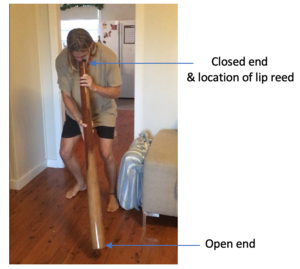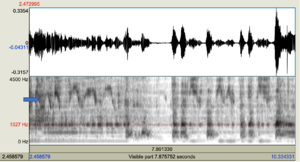Course:Phys341 2020/Didgeridoo

The didgeridoo is a seemingly simple ancient wind instrument originating from Australia. However, the complex interactions between the vocal tract and the instrument allow for the creation of many timbres, despite its generation of only one perceived pitch (eg. The sound of the Didgeridoo ).
What is the Didgeridoo?
The didgeridoo, also known as the yidaki, is an ancient instrument that originated with the aboriginal peoples of Northern Australia[1]. Traditionally, it is made from Eucalypts trunks that have been hollowed out by termites, leading to each one having a unique and irregular shape [1]. They tend to be cut to approximately 1.5 meters long and are usually somewhat conical (Fig.1.), with a smaller diameter as well as a ring of beeswax at the blowing end[1].
Playing the Didgeridoo
The player seals the blowing end of the instrument with the skin around their mouth and creates the primary sound source by vibrating their lips. Continuous lip vibration is made possible by circular breathing, which involves the player filling their cheeks with air and expelling this stored air while simultaneously inhaling quickly through their nose[1]. During inhalation, the mouth cavity is isolated from the rest of the vocal tract, shortening the air cavity substantially, which has consequences for the musical timbre and the rhythm of play [2].
Changes in the shape and position of the player’s tongue provides the primary means for varying the timbre of the didgeridoo [3]. While playing, the vocal folds are almost closed, separating the vocal tract from the lungs while still allowing air movement, and are only rarely vibrating [3]. If the vocal folds are vibrating in addition to the lips, there are two sources creating vibrations within the vocal tract, adding complexity to the resultant timbre[2]. Additionally, there is some evidence that experienced players may subconsciously move their glottis up and down, serving to change the length of their vocal tract and therefore also the sound quality [4].
Acoustics of the Didgeridoo
Introducing Energy into the System: Lip Reed
The lip vibration used while playing the didgeridoo, which functions to introduce energy into the system, conforms to Bernoulli’s principal. The lips are first held loosely shut, and then, as air is expelled from the player’s lungs, pressure builds up behind the lips eventually forcing them to open. As the air accelerates through the lips, the air pressure between the lips rapidly decreases, which pulls the lips back together again. As pressure once again builds up behind the lips, the cycle restarts[5]. This results in periodic pulses of air entering the air cavity of the didgeridoo as well as the vocal tract, which can be seen as vertical striations on a spectrogram (Fig.2.). These pulses generate a harmonic series with a frequency ratio of 1:2:3…etc[5]. Both the vocal tract and the didgeridoo then act on this harmonic series by amplifying and damping certain frequencies, creating the musical quality, or timbre, that the listener hears.
(In)harmonicity
The didgeridoo can be imperfectly represented by a pipe closed at the blowing end by the lips (Fig.1.)[2]. This model would suggest that the air pressure at the open end is (approximately) fixed and the air pressure at the closed end fluctuates maximally, resulting in a harmonic series with a frequency ratio of 1:3:5…etc[5]. However, because the didgeridoo is slightly conical, rather than perfectly cylindrical, and the inside surface is highly irregular due to the work of the termites, the simple open-closed pipe model serves only as a crude approximation. Instead, the didgeridoo has been described as having a “stretched quasiharmonic sequence” [3], resulting in a sound that is less pure than a pipe with a constant diameter would generate[6]. In other words, the didgeridoo enhances certain frequencies (from the harmonic series created by lip vibrations) that are not integer multiples of each other.
Two Resonators
Lip vibrations transmit energy into the didgeridoo as well as into the vocal tract, meaning there are two resonators simultaneously working to amplify and dampen certain frequencies[2]. The vocal tract is therefore “working backwards” in comparison to how it functions during speech when the vocal folds are the main source of sound[2]. Because the didgeridoo has a constant length and shape, variations in timbre are created by modifying the configuration of the vocal tract. However, the air cavities of the vocal tract and the didgeridoo are well coupled, meaning the vibrations of one greatly influence the vibrations of the other, chiefly because the diameter of the mouthpiece is quite large compared to other wind instruments [1].

The pitch perceived by the listener is created by the player’s lip vibration, which generates a fundamental frequency that tends to be fixed around 70 Hz [3]. This pitch, referred to as a “drone” because circular breathing allows for its continuous maintenance, is near the lowest resonance of the didgeridoo and so is amplified[1].
Despite there being only one pitch, a large range of timbres can be generated while playing the didgeridoo. Strong formants, or bands of enhanced frequencies, are created and varied by changing the shape, and therefore the resonant characteristics, of the vocal tract[2]. Acoustic impedance, a measure of how easily sound waves travel through a medium, plays a key role in creating the formants that are characteristic of the didgeridoo. As the tongue increases in height, constricting the diameter of the vocal tract, vocal tract impedance increases which works to inhibit certain frequencies, depending on where in the vocal tract the constriction occurs [2]. For example, when the player’s tongue is very near the front of the roof of their mouth, a formant is created somewhere between 1 and 2 kHz, depending on individual differences in vocal tract anatomy [2]. In Fig.2., this formant can be seen near 1.3 kHz, meaning the frequencies on either side of 1.3 kHz are inhibited. Formants are then altered rhythmically to create a musical quality to the generated sound[3]. This is most clearly illustrated in Fig.2. by the formant around 3 kHz.
As previously mentioned, circular breathing also contributes to the timbre. During the inhalation phase, the vocal tract resonator is shortened to include only the mouth cavity as the soft palate lowers to allow inhalation through the nose. This works to briefly increase the frequencies amplified by the air cavity, which experienced players use to create a rhythm of play[1].
References
- ↑ 1.0 1.1 1.2 1.3 1.4 1.5 1.6 Tarnopolsky, A. Z., Fletcher, N. H., Hollenberg, L. C. L., Lange, B. D., Smith, J., & Wolfe, J. (2006). Vocal tract resonances and the sound of the Australian didjeridu (yidaki), I: Experiment. Journal of the Acoustical Society of America, 119(2), 1194. doi:10.1121/1.2146089
- ↑ 2.0 2.1 2.2 2.3 2.4 2.5 2.6 2.7 University of New South Wales. (n.d.). Didgeridoo acoustics/yidaki acoustics. Music acoustics. http://newt.phys.unsw.edu.au/jw/didjeridu.html
- ↑ 3.0 3.1 3.2 3.3 3.4 Fletcher, N. H., Hollenberg, L. C. L., Smith, J., Tarnopolsky, A. Z., & Wolfe, J. (2006). Vocal tract resonances and the sound of the Australian didjeridu (yidaki), II: Theory. Journal of the Acoustical Society of America, 119(2), 1205. doi:10.1121/1.2146090
- ↑ Tarnopolsky, A. Z., Fletcher, N. H., Hollenberg, L. C. L., Lange, B. D., Smith, J., & Wolfe, J. (2005). The vocal tract and the sound of a didgeridoo. Nature, 436, 39. doi:10.1038/43639a
- ↑ 5.0 5.1 5.2 White, D., White, H. (1980). Physics and music. Saunders College.
- ↑ How Didgeridoos Work. (n.d.). Physics.org. http://www.physics.org/featuredetail.asp?id=18